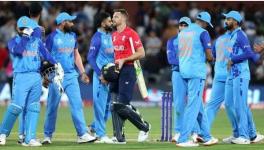BCCI Should Plan Holistic Revamp of Indian Domestic Cricket | On the Ball

Karnataka cricket team won the 2019 Vijay Hazare Trophy, beating Tamil Nadu in the final. The match, which features Indian cricket team players as well, attracted more than 4,000 spectators.
More than 4,000 people for a domestic game. In the heart of a pedigreed cricketing city, on a weekday. Friday provided a shot in the arm for domestic cricket, reiterating that under the right circumstances, it need not sail in relative anonymity, or in the wake of its more celebrated international counterpart.
That there were nearly a dozen recent and past internationals parading their wares in the most prestigious 50-over competition in the country didn’t hurt. Karnataka and Tamil Nadu share a glorious history of tight contests and a storied rivalry dating back to nearly nine decades. The passage of time, the scrapping of the zonal system, the cross-pollination of players that is an inevitable outcome of franchise-based cricket, and the proliferation of India ‘A’ outings has taken the edge off a rivalry that has often teetered on the edge. But there is no shortage of the fierce desire to win when the two southern rivals go head-to-head, especially not with a major trophy on the line.
Also Read | To Dhoni or Not to Dhoni and More: Questions Remain as BCCI Rolls With Cloak-Work Efficiency
The M Chinnaswamy Stadium in Bengaluru did not throw up a contest worthy of the occasion — the final of the Vijay Hazare Trophy — but that’s only because collectively, and riding on the passion of their die-hard followers, Karnataka bossed over their opponents. Birthday boy Abhimanyu Mithun laid down the marker in the first over by nicking off M Vijay, and celebrated turning 30 with the first hat-trick ever in the final of the competition. KL Rahul and, more mesmerically, Mayank Agarwal then turned the title tilt into a no-contest, rapidly clattering towards the target so that by the time the inevitable rain arrived, Karnataka were well ahead of the par score.
In some ways, it was perhaps fitting that there was no logical denouement to the final, because this was a tournament seriously affected by the weather from day one, on September 24. Unlike in the SENA — South Africa, England, New Zealand and Australia — countries where cricket is a summer sport, the season in India doesn’t start until August. Of course, for the last 12 years, the Indian Premier League (IPL) has come to occupy the summer calendar, but it is practically impossible to schedule 50-over and day-cricket during peak summer when temperatures often scale the 40-degree Centigrade mark.
The rains forced a frantic scramble for rescheduling of the tournament, with league matches washed out in the early stages across Bengaluru, Vadodara, Jaipur and Dehradun reinstated without extending the length of the competition. That was a smart, rational if out-of-the-box move from the Board of Control for Cricket in India because especially at the start of the season, it can be most depressing for players to be denied the opportunity to make a statement by factors beyond their control. So far so good.
But the playing conditions for the knockout matches left a lot to be desired. In the event of a no-result in the knockouts (not including the final), the first criterion to decide the winner was the number of wins secured by the teams in the league phase. That would have raised no hackles had there been an equitable quantitative and qualitative distribution of teams across the four groups. Instead, the stronger Groups A and B had nine teams each, the slightly less weak — by the BCCI’s yardstick, not ours — Group C had 10 sides, as did the Plate group, comprising teams that only recently were conferred the right to participate in these tournaments.
It was just as well that the quarterfinal between eventual champions Karnataka and Pondicherry was not abandoned for, in that case, the latter would have gone through because even though they had the same number of wins as their more celebrated foes, they boasted a far superior net run-rate. Pondicherry’s wins came against the likes of Manipur, Arunachal Pradesh, Mizoram and Sikkim, among others; Karnataka had to overcome former champions Mumbai, and domestic powerhouses Saurashtra and Jharkhand. That doesn’t suggest a level-playing field.
Also Read | Sultan of Johor Cup Review: Future of Indian Hockey in Nobody’s Hands
The most-wins conundrum was a throwback to the ICC World Cup final, which was decided on the boundary countback after even a Super Over failed to separate England from New Zealand. The playing conditions are in place to guard against any and all eventualities, but their merit often leaves a lot to be desired, especially with the benefit of hindsight.
Mumbai and Punjab’s ouster in the quarters on fewer wins compared to Chhattisgarh and Tamil Nadu respectively, especially when both were on course for victory when the games were called off, will have to necessitate a change in mindset, and the rules, to prevent such embarrassment going forward.
Sourav Ganguly, the new president of the BCCI, has been vocal in his early days on addressing first-class cricket/cricketers post-haste. That’s a welcome development because it is precisely that level which acts as a feeder to the national side. But upliftment of domestic cricket doesn’t stem only from enhanced remuneration. It must percolate to more prudently thought out rules, to good playing surfaces and outfields, to proper scheduling, and to leave enough time between matches and tournaments so that it doesn’t seem as if the boxes are merely being ticked and the formalities completed.
Of equal import is the upkeep of grounds. To cram matches in one city/state could spark a deadening of pitches even before the start of the Ranji Trophy. Given the clamour to host international cricket and the heat that Virat Kohli’s ‘five Test venues’ comment has generated, it is clear that there is no shortage of grounds, or the willingness to host matches, across the country. Equitable distribution of hosting status when it comes to domestic cricket has to be non-negotiable, and not only because players then get to experience different conditions and situations.
That should, however, not be at the expense of sub-par pitches or poorly maintained outfields. With infrastructure at the top of the agenda for the more established state associations, efforts must be made to protect as much of the ground as possible from the deleterious after-effects of rain. As crucially, the hard-working and never-complaining ground staff must also be provided with adequate protection from the elements. There is no joy in trying to cover the square and the outfield in driving rain when you yourself are soaked to the bone because there is no water-proof apparel.
Video | South Africa Cricket Team's Slump vs India and the Big Rot Back Home
That Agarwal and R Ashwin chose to dash down from Ranchi immediately at the conclusion of the final Test against South Africa to represent their respective states is a clear indication that players are still willing to walk the extra mile when the occasion so presents itself.
Packed international schedules might preclude such stirring tales on a more regular basis, but it is clear that for the players, no matter how successful globally, the lure of the domestic game is still powerful. It then becomes incumbent upon the administrators to make the most of that burning fire. That should be Ganguly’s first priority — to delve into domestic cricket more holistically than merely increasing match-fees.
(Kaushik is a veteran cricket writer who has reported on over 100 Tests. He co-authored VVS Laxman's autobiography '281 and Beyond')
Get the latest reports & analysis with people's perspective on Protests, movements & deep analytical videos, discussions of the current affairs in your Telegram app. Subscribe to NewsClick's Telegram channel & get Real-Time updates on stories, as they get published on our website.
























